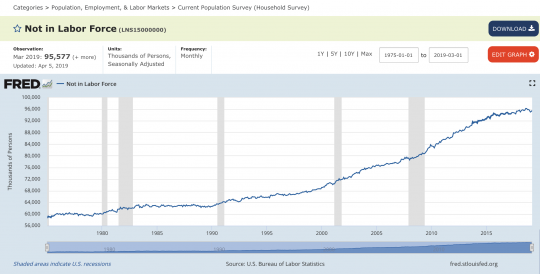 Just like in 2008, most Americans are living right on the edge financially, and so any sort of an economic downturn is going to be extremely painful for tens of millions of American families. When you have not built up a financial cushion, any sort of a setback can be absolutely disastrous. During the last recession, millions of Americans suddenly lost their jobs, and because most of them were living paycheck to paycheck a lot of them suddenly couldn’t pay their mortgages. In the end, millions of Americans lost their homes during the “subprime mortgage meltdown”, and today the housing bubble is even larger than it was back then. Sadly, the reality of the matter is that many of us are just barely scraping by from month to month, and that is a very dangerous position to be in.
Just like in 2008, most Americans are living right on the edge financially, and so any sort of an economic downturn is going to be extremely painful for tens of millions of American families. When you have not built up a financial cushion, any sort of a setback can be absolutely disastrous. During the last recession, millions of Americans suddenly lost their jobs, and because most of them were living paycheck to paycheck a lot of them suddenly couldn’t pay their mortgages. In the end, millions of Americans lost their homes during the “subprime mortgage meltdown”, and today the housing bubble is even larger than it was back then. Sadly, the reality of the matter is that many of us are just barely scraping by from month to month, and that is a very dangerous position to be in.
A new survey that was just released shows just how vulnerable American consumers have become at this point in time. According to the survey, the top financial priority for 38 percent of all Americans is just trying to pay the bills, and for 19 percent of all Americans it is dealing with credit card debt. The following comes from Fox Business…
Among survey respondents in the nationally representative poll, 38 percent said their top financial priority is “just staying current on living expenses or getting caught up on all the bills.” Almost 3 in 10 respondents (29 percent) said their chief priority was “saving more money,” and 19 percent indicated they were mainly working on paying down debt from products like credit cards and student loans.
So that means that for nearly 60 percent of all Americans, the top financial priority each month is either finding a way to pay the bills or dealing with credit card debt.
And if you are struggling to pay the bills each month or you are drowning in credit card debt, the truth is that you are definitely not ready for the next recession.
The same survey also discovered that a very large percentage of Americans are not following any sort of a financial budget…
More than a decade into the longest economic expansion on record, almost two-fifths of people said in a new Bankrate poll that their main financial priority was just keeping their heads above water on living expenses rather than saving money.
Nearly as many of those surveyed said that they’re not following financial budgets, according to Bankrate’s September Financial Security Poll.
So many people out there spend money whenever they feel like it and they don’t have any sort of a plan for their finances.
And then when they get deep into debt they wonder how that could have possibly happened.
It is so important to take charge of your money and to have a plan for where you want to go financially. Because if you don’t have a plan for your money, I promise you that somebody else does. As many of us have learned the hard way, it is all too easy to fall victim to all of the financial predators that are constantly circling these days. The big financial institutions want to get Americans into as much debt as possible, because the deeper we are in debt the more money they make.
In our society, everything has become all about extracting as much money out of you as possible. Even when we are at the checkout counter at the supermarket we are asked if we want to get some “cash back” so that they can charge us a “convenience fee” and make even more money. And of course most of the money that is extracted out of us ultimately ends up at the very top of the financial pyramid, and as a result the gap between the “haves” and the “have nots” continues to grow.
In fact, the U.S. Census Bureau is telling us that the gap between the rich and the poor is now “greater than it has ever been”…
In the midst of the longest economic expansion the United States has ever seen, with poverty and unemployment rates at historic lows, the separation between rich and poor from 2017 and 2018 was greater than it has ever been, federal data show.
To be fair, the U.S. Census Bureau has only been measuring this since 1967, and so it is entirely possible that things could have been even worse earlier in our history.
But the numbers do clearly show that the gap has been steadily widening for years, and at this point wealth inequality in the U.S. is far greater than it is in any country in Europe…
The Gini index measures wealth distribution across a population, with zero representing total equality and 1 representing total inequality, where all wealth is concentrated in a single household. The indicator has been rising steadily during the past several decades. When the Census Bureau began studying income inequality more than 50 years ago, the Gini index was 0.397. In 2018, the Gini index rose to 0.485.
By comparison, no European country had a Gini index greater than 0.38 between 2017 and 2018.
So what this means is that we have a small group of people at the top of the pyramid doing really, really well, but meanwhile most of the rest of us are deeply struggling.
In fact, survey after survey has shown that the vast majority of Americans are currently living paycheck to paycheck.
The way that our entire system is structured greatly favors Wall Street, the big banks, the largest corporations and those with enormous amounts of money. And they are able to maintain control of the system by literally buying elections and controlling public opinion through their control of the mainstream media. Our founders were deeply suspicious of large concentrations of power, and we need to return to the values that our nation was founded upon if we ever hope to turn things around.
Unfortunately, more Americans that ever are convinced that socialism is the answer to the problems that I just discussed, and this is fueling the rise of politicians such as Bernie Sanders and Elizabeth Warren.
But socialist experiments have failed all throughout human history, and socialism would fail here too.
Big government is never the answer. Sadly, we already have the biggest government in the history of the world, and many Americans seem absolutely determined to make it even bigger.
 About the author: Michael Snyder is a nationally-syndicated writer, media personality and political activist. He is the author of four books including Get Prepared Now, The Beginning Of The End and Living A Life That Really Matters. His articles are originally published on The Economic Collapse Blog, End Of The American Dream and The Most Important News. From there, his articles are republished on dozens of other prominent websites. If you would like to republish his articles, please feel free to do so. The more people that see this information the better, and we need to wake more people up while there is still time. Of course the most important thing that we can share with people is the gospel of Jesus Christ, and if you would like to learn more about how you can become a Christian I would encourage you to read this article.
About the author: Michael Snyder is a nationally-syndicated writer, media personality and political activist. He is the author of four books including Get Prepared Now, The Beginning Of The End and Living A Life That Really Matters. His articles are originally published on The Economic Collapse Blog, End Of The American Dream and The Most Important News. From there, his articles are republished on dozens of other prominent websites. If you would like to republish his articles, please feel free to do so. The more people that see this information the better, and we need to wake more people up while there is still time. Of course the most important thing that we can share with people is the gospel of Jesus Christ, and if you would like to learn more about how you can become a Christian I would encourage you to read this article.

















